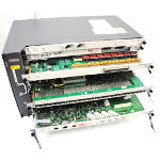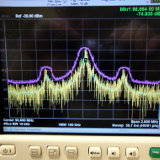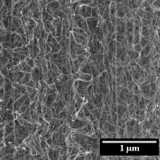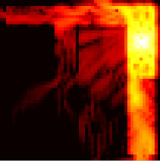Projects
Shielding measurement of electrically large enclosures with contents
 Development and implementation of production enclosure shielding effectiveness qualifications methodologies
for certification of ICT enclosures from 1 to 26 GHz. This project funded by Huawei Technologies
delivered reverberation chamber measurement and full-wave simulation based assessment methods for use in
Huawei’s Global Compliance and Testing Center. (November 2014 - September 2016)
Development and implementation of production enclosure shielding effectiveness qualifications methodologies
for certification of ICT enclosures from 1 to 26 GHz. This project funded by Huawei Technologies
delivered reverberation chamber measurement and full-wave simulation based assessment methods for use in
Huawei’s Global Compliance and Testing Center. (November 2014 - September 2016)
Electromagnetic monitoring of semiconductor ageing (EMSA)
 A feasibility study for the
EPSRC Centre for Innovative Manufacturing in Through-life Engineering Services
investigating a non-invasive method to monitor ageing of semi-conductors from their electromagnetic emission and re-emission spectra.
This project verified that the change in the non-linear behaviour of semiconductor devices could be identified in a way that does not
require modification of existing circuitry, thus allowing through-life and non-destructive monitoring of devices for signs of early deterioration.
(September 2013 - February 2014)
A feasibility study for the
EPSRC Centre for Innovative Manufacturing in Through-life Engineering Services
investigating a non-invasive method to monitor ageing of semi-conductors from their electromagnetic emission and re-emission spectra.
This project verified that the change in the non-linear behaviour of semiconductor devices could be identified in a way that does not
require modification of existing circuitry, thus allowing through-life and non-destructive monitoring of devices for signs of early deterioration.
(September 2013 - February 2014)
Electromagnetic properties of nanostructured materials
 Nanomaterials are becoming increasingly important for many applications in which knowledge of their high-frequency electromagnetic
properties is essential. This project extended the measurement capability of the AEG to higher frequencies using
funding from the University of York Research Priming Fund. (August 2013 - July 2015)
Nanomaterials are becoming increasingly important for many applications in which knowledge of their high-frequency electromagnetic
properties is essential. This project extended the measurement capability of the AEG to higher frequencies using
funding from the University of York Research Priming Fund. (August 2013 - July 2015)
Strategies for the Improvement of Critical Infrastructure Resilience to Electromagnetic Attacks (STRUCTURES)
 Development and demonstration of methodologies that can be applied for analysis of the risks associated with possible attacks
on critical infrastructures using intentional electromagnetic interference and identification of the mitigation techniques that
can be applied. The scope of this ERC funded projected ranged from localised jamming of wireless communications using “home-made”
sources to high altitude nuclear electromagnetic pulses.
(July 2012 - June 2015)
Development and demonstration of methodologies that can be applied for analysis of the risks associated with possible attacks
on critical infrastructures using intentional electromagnetic interference and identification of the mitigation techniques that
can be applied. The scope of this ERC funded projected ranged from localised jamming of wireless communications using “home-made”
sources to high altitude nuclear electromagnetic pulses.
(July 2012 - June 2015)
High frequency radiated field synthetic environment (HIRF SE)
 The electromagnetic environment in which air vehicles have to operate is becoming increasingly
complex. Evaluating and qualifying air vehicles for operation in this environment is currently
predominantly done using measurements on prototype air vehicles, which is very costly, especially if remedial
action is found to be necessary. The ERC funded HIRF SE project provided the foundations for a computational
framework to enable electromagnetic aspects of air frame design to be evaluated and qualified using simulation
at the design stage of development, offering the potential for reduced costs and enhanced safety.
(December 2008 - May 2013)
The electromagnetic environment in which air vehicles have to operate is becoming increasingly
complex. Evaluating and qualifying air vehicles for operation in this environment is currently
predominantly done using measurements on prototype air vehicles, which is very costly, especially if remedial
action is found to be necessary. The ERC funded HIRF SE project provided the foundations for a computational
framework to enable electromagnetic aspects of air frame design to be evaluated and qualified using simulation
at the design stage of development, offering the potential for reduced costs and enhanced safety.
(December 2008 - May 2013)
Segmented hydration analysis using resonance perturbation (SHARP)
This feasibility study funded by the White Rose Health Innovation Partnership developed method-of-moments computational models for a local body water measurement system based on resonant cavity perturbation theory. The models were used to investigate radiative effects and the near-field behaviour of the system. (January 2008 - August 2008)
Development of a continuous sweep RF harmonic spectral analysis detector (SAFETALK)
An ERC funded project that delivered an affordable “walk-through” portal capable of detecting a variety of electronic devices used for IP theft. Detection and identification of such devices enables subsequent prevention of their owners from entering sensitive areas and thus improves information security. (June 2007 - February 2009)
Flapless air vehicle integrated industrial research: Electromagnetics (FLAVIIR)
The electromagnetics project of the EPSRC and BAE Systems FLAVIIR programme developed and optimised a material shielding effectiveness measurement system for composite materials using transmission line matrix simulations and implemented nested reverberation chamber shielding measurements. It also provided a test-suite for validating electromagnetic solvers for modelling reverberant environments. (June 2005 - May 2007)
Interaction of emerging mobile telecommunication systems with the human body
As part of the LINK-MTHR/Department of Health research programme this project developed computational models and methods for performing electromagnetic dosimetry of the new exposure scenarios brought about by the move to data-centric mobile communication systems. (April 2002 - November 2011)
Exposure assessment of hands-free-kits
This project, funded directly by the DTI under the oversight of the LINK-MTHR/Department of Health research programme, developed measurement protocols for mobile phone hands-free-kit exposure assessment. The preliminary findings showed that while the median exposure of the head when using a wired hands-free-kit may be lower than when using a mobile phone directly next to the head, the worst-case exposure can be at a similar level. (April 2002- March 2003)
Immunity modelling and analysis of GENEC
Development of fast intermediate-level circuit models for circular cross-section cavities, including models for small apertures supported by validating immunity measurements for QinetiQ. (November 2000 - October 2001)
Platform grant in electromagnetic compatibility
Part of the AEG’s EPSRC Platform Grant in Electromagnetic Compatibility was devoted to the development of computational electromagnetics codes and enhancement of the electromagnetic compatibility laboratory measurement facilities. (August 2008 - March 2002)
Measurement and evaluation of exposure to UMTS (MEETUMTS)
A DTI funded preliminary assessment of the impact of third generation mobile communication systems on the radio-frequency exposure of the users. (May 199 - July 2001)
Electromagnetic compatibility aspects of future radio telecommunication systems
Part of the LINK Personal Communications Programme, this project investigated the impact of ubiquitous mobile communication device usage on wired communication systems due to distributed interference effects. (April 1996 - April 1999)